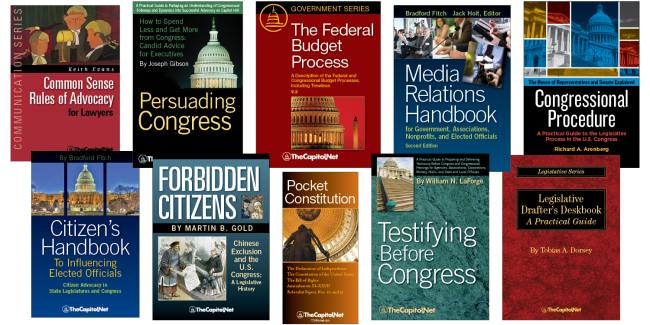From the Congressional Glossary – Including Legislative and Budget Terms
Amendment Tree / Filling the Tree

“Amendment trees” are charts that illustrate certain principles of precedence that guide the Senate amendment process. When all of the amendments permitted simultaneously by these principles of precedence have been offered and are pending, an amendment tree is said to be “filled,” and no additional amendments may be offered until one or more of those pending is disposed of or laid aside. Given that the presiding officer traditionally affords the Senate majority leader or his designee priority over all others in being recognized, a majority leader can repeatedly secure recognition and “fill the amendment tree” by sequentially offering all of the amendments permitted under applicable circumstances. By doing so, a leader can “freeze” the amendment process in place, blocking additional floor amendments, at least temporarily.
Degrees of Amendment: Designations that indicate the relationship of an amendment to the text of a measure and of one amendment to another. Amendments are permitted only in two degrees.
An amendment to the base text is called a first-degree amendment. Such an amendment can be further amended by either a substitute amendment (which is also a first-degree amendment) or a perfecting amendment, called a second-degree amendment. The substitute is also subject to a perfecting amendment. These four amendments constitute what is referred to as the amendment tree. Once an amendment to a measure is pending, either a perfecting amendment or a substitute amendment can be offered first.
Substitute Amendment: Amendment that replaces the entire text of a pending amendment.
A perfecting amendment is an amendment that alters, but does not completely substitute or replace, language in another amendment.
The option of resolving differences between the two chambers, i.e., Amendments Between the Houses–the process of amendments between the chambers–allows two degrees of amendments. The amendment of the second chamber is considered text that is subject to amendment. Each chamber has one opportunity to propose an amendment to the amendment of the other chamber. The process is often conducted by informal negotiations between the members and staff of the committees of jurisdiction in the two houses. An extended exchange of amendments is rare.
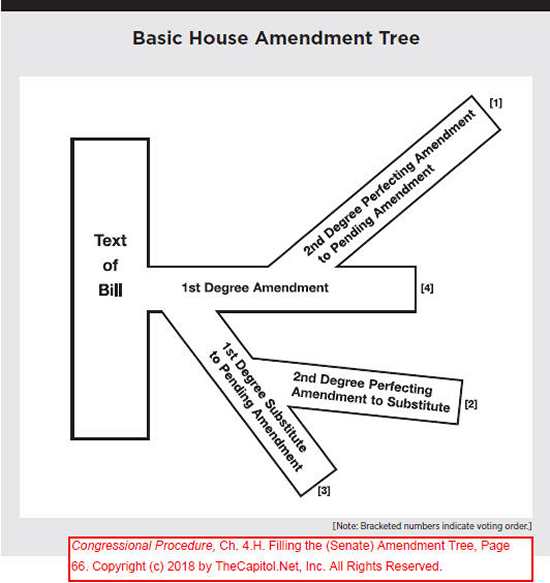
Congressional Procedure, Ch. 4.H. House Amendment Tree, page 66
“I cannot believe he would tell a flat-out lie.” (C-SPAN)
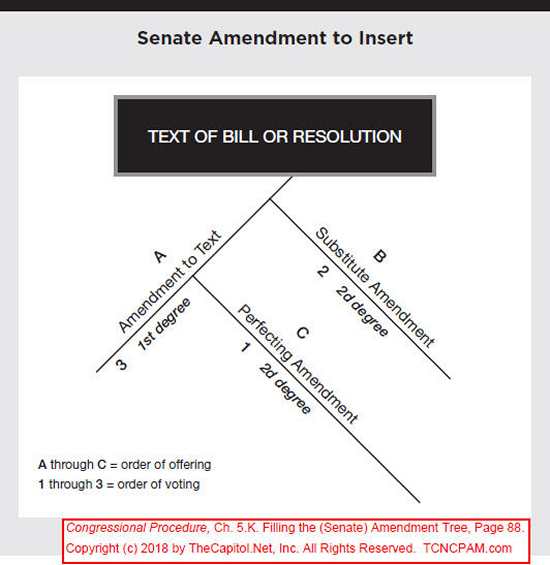
Congressional Procedure, Ch. 5.K. Senate Amendment To Insert, page 88
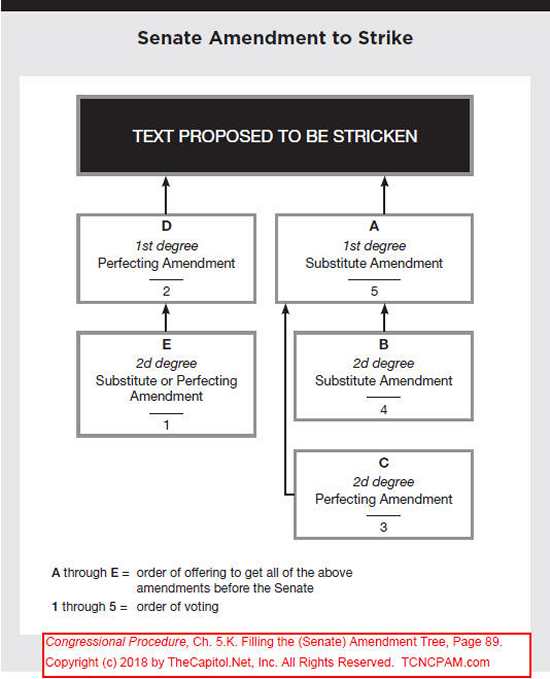
Congressional Procedure, Ch. 5.K. Senate Amendment To Strike, page 89
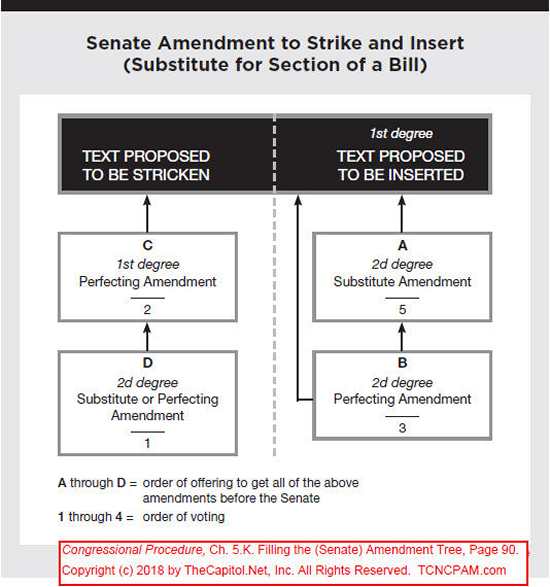
Congressional Procedure, Ch. 5.K. Senate Amendment To Strike And Insert, page 90
A majority leader might “fill the tree” in this way to prevent the offering of or voting on of non-germane amendments, to try to speed up consideration of a measure, or to control the subject or sequence of amendments that may be offered.
If all four of these amendments are pending, the order of voting is as follows:
1. the perfecting amendment to the amendment to the bill (a second-degree amendment)
2. the perfecting amendment to the substitute (a second-degree amendment)
3. the substitute (considered a first-degree amendment)
4. the base amendment to the text
When an amendment has been disposed of, a branch of the amendment tree is open. An additional amendment may then be offered, provided that the new amendment does not propose to change what has already been amended.
Bennett: “I Won’t Get an Opportunity to Vote on the DREAM Act”
Also see
- Amendment (CongressionalGlossary.com)
- Amendment in the Nature of a Substitute (CongressionalGlossary.com)
- Amendments Between the Houses (Chambers) / Insist / Amendments in Disagreement / Amendments in Technical Disagreement (CongressionalGlossary.com)
- Germane / Germaneness (CongressionalGlossary.com)
- Majority Leader (CongressionalGlossary.com)
- Nongermane Amendment (CongressionalGlossary.com)
- Chapter 3.F. Amendment Procedure; Chapter 4.H. Amendment on the House Floor; Chapter 5.J. Amendment on the Senate Floor and in Committee; Chapter 5.K. Filling the (Senate) Amendment Tree; in Congressional Procedure
Unwritten Rules of Congress | Ron’s Office Hours | NPR
More
- Congressional Leadership
- Filling the tree – Wikipedia
- “The Amending Process in the House of Representatives,” CRS Report 98-995 (49-page PDF
 )
) - “Filling the Senate ‘Amendment Tree’“, CRS Insight IN10329 (3-page PDF
 )
) - “Filling the Amendment Tree in the Senate,” CRS Report RS22854 (10-page PDF
 )
) - “The Amending Process in the Senate,” CRS Report 98-853 (38-page PDF
 )
) - “Senate Procedure From a House Perspective,” Parliamentary Boot Camp (4-page PDF
 )
) - “Legislative Procedure in Congress: Basic Sources for Congressional Staff,” CRS Report RS21363 (12-page PDF
 )
) - “Amendment Process in the Committee of the Whole,” CRS Report 98-439 (8-page PDF
 )
) - “House Committee Markups: Manual of Procedures and Procedural Strategies,” CRS Report R41083 (220-page PDF
 )
)
Courses
- Congressional Operations Briefing – Capitol Hill Workshop
- Drafting Federal Legislation and Amendments
- Writing for Government and Business: Critical Thinking and Writing
- Custom, On-Site Training
- Drafting Effective Federal Legislation and Amendments in a Nutshell, Audio Course on CD
- Congress, the Legislative Process, and the Fundamentals of Lawmaking Series, a Nine-Course series on CD
Publications
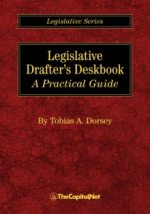
Legislative Drafter’s Deskbook: A Practical Guide

Pocket Constitution
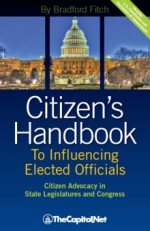
Citizen’s Handbook to Influencing Elected Officials: A Guide for Citizen Lobbyists and Grassroots Advocates
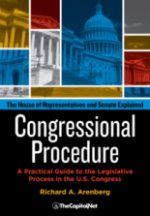
Congressional Procedure
CongressionalGlossary.com, from TheCapitol.Net
For more than 40 years, TheCapitol.Net and its predecessor, Congressional Quarterly Executive Conferences, have been teaching professionals from government, military, business, and NGOs about the dynamics and operations of the legislative and executive branches and how to work with them.
Our custom on-site and online training, publications, and audio courses include congressional operations, legislative and budget process, communication and advocacy, media and public relations, testifying before Congress, research skills, legislative drafting, critical thinking and writing, and more.
TheCapitol.Net is on the GSA Schedule, MAS, for custom on-site and online training. GSA Contract GS02F0192X
TheCapitol.Net is now owned by the Sunwater Institute.
Teaching how Washington and Congress work ™

